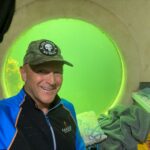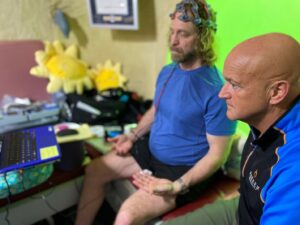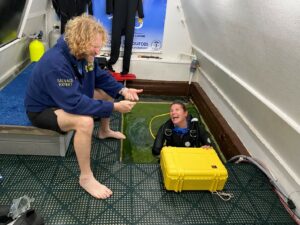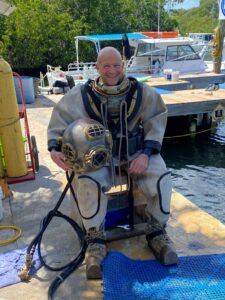On March 31, William Morgan, DC, president of Parker University, entered the waters near Key Largo, Fla., to spend 24 hours in an undersea habitat with his friend, Joe Dituri, PhD, a legend in the world of deep-sea diving and the use of therapeutic hyperbaric chambers. Often called Dr. Deep Sea, Dr. Dituri was on his way to spending 100 days submerged undersea [at pressure]* and to breaking the world’s record. This undertaking was conducted to find out what positive effects prolonged hyperbaric (increased pressure) and increased oxygen consumption may have on the human body.

During his time in an undersea marine lab named for the 19th century futuristic writer Jules Verne, Dr. Morgan interviewed Dr. Dituri about his mission and the scientific value of this endeavor. Spending 24 hours underwater at pressure qualified Morgan as an aquanaut, the undersea counterpart of an astronaut.
ACA was able to catch up with Dr. Morgan and ask him about his undersea adventure:
How did the idea of spending 24 hours underwater with Dr. Dituri come about?
Dr. Morgan: Because many chiropractors use low pressure hyperbaric chambers in their practices, several years ago I went searching for a speaker on hyperbaric medicine for one of Parker’s NeuroCON Seminars. As a former Navy diver and qualified Special Operations Technician (diving medicine technician/combat diver), I knew that the industry had inconsistent application of the science of hyperbaric oxygen therapy. So, I wanted a world-class authority on the topic to provide clarification. Everyone I asked in the Navy diving community pointed me to Joe Dituri.
Dr. Dituri became a Parker speaker, and since then he and I have been friends. I visited his hyperbaric clinic in Tampa, Fla. When I learned that Dr. Dituri was going to attempt to spend 100 days underwater, I knew that I wanted to participate in this project.
How does being underwater that long affect the body and the MSK system?
Dr. Morgan: A hyperbaric environment (increased pressure) has many effects on the human body. Some of these effects are positive, while some of them are deleterious. On the positive side it has been noted in both animal and human studies that exposure to a mild hyperbaric environment can increase telomere length. Telomeres have an impact on cell reproduction and longevity. Hyperbaric treatments have also been used for limb salvage, the treatment of osteoporosis, avascular necrosis, sarcopenia, anemia, carbon monoxide poisoning, hypoxic brain injuries, and even COVID-19. However, on the negative side, oxygen becomes toxic at too great a depth and can cause pulmonary and central nervous system damage. Nitrogen, also at great depths, has a narcotic influence on divers.

Another topic we can learn about from hyperbaric physiologists is regarding the audible “pop” heard from a chiropractic adjustment. During a chiropractic adjustment, gas is released from fluid in what is called tribonucleation. Tribonucleation is replacing the term cavitation when describing the formation of a small bubble in the joint when an adjustment is delivered. Diving physiologists have been studying tribonucleation for one hundred years in their quest to better understand decompression sickness (the bends) and air embolisms. Most of the research on this topic is contained in the research of diving injuries. If we want to better understand the mechanical effects of the adjustment, we need to learn more about tribonucleation from diving physiologists.
What can studying the body underwater reveal about improving performance and/or alleviating pain?
Dr. Morgan: Parker Performance Institute (PPI) is a clinic which uses a unique combination of professions, providers, treatments, and modalities. While we are still researching outcomes, some of our clinical observations show that combining certain treatments may have a compounding effect instead of an incremental increase in efficiency. The result of this means that adding 1+1 may not equal 2, but instead equal 10.
We are using a variety of treatment combinations at PPI to see what works best for various conditions. We may find that combining hyperbaric treatment with chiropractic will yield a greater compounded improvement than the expected incremental stacking efficiency of the treatments.
Hyperbaric chambers have been used to accelerate healing, reduce pain, and increase oxygen delivery to injured tissues. So as a healthcare university, it is natural that Parker would have an interest in this modality.
What psychological effects, if any, has Dr. Dituri experienced?
Dr. Morgan: It will take months to tease out some of the results from the metrics measured by the physicians and scientists concerning the effects of pressure on Dr. Dituri, both physiologically and psychologically. Some of the positive effects may be countered by other factors such as reduction in exercise, an altered circadian rhythm (caused by lack of exposure to daylight), reduced vitamin D and other benefits of daylight, and musculoskeletal pain from living in cramped quarters with a low ceiling.
By the time I arrived in the marine lab a few weeks into the mission, Dr. Dituri had already named the lobsters and crabs which lived within sight of the viewing portholes and could recognize their individual characteristics and appearance. That leaves a clue to the behavior components of living in a confined environment.
Describe Jules’ Undersea Lodge. Is it comfortable?
Dr. Morgan: Jules’ Undersea Lodge is a 50-year-old marine undersea research laboratory that began its existence facilitating research projects on the continental shelf off the coast of Puerto Rico before being relocated to Key Largo. It is very comfortable, as comfortable as two cylinders eight feet in diameter can be. I found it to be relaxing, and I slept very well there. Dr. Dituri feels that the increase in oxygen provides more restorative sleep. (Sleep quality was one of the physiological effects being measured.)
I had my own, albeit confined, berth space. But it was comfortable and allowed a great opportunity for reflection and thought while I was there.
What is your favorite memory from the experience?

Dr. Morgan: It was surprisingly relaxing to hang out in the lodge with Joe and to go diving from the habitat. I appreciated interviewing Joe and learning some diving physiology. The dives were enjoyable, but one of the most memorable experiences was having a piping hot pizza delivered in a watertight pelican case by one of the volunteer divers supporting Joe’s research. I would have never imagined having a diver pop into the undersea entry port with a big, beautiful smile and a pizza! Then, as we sat eating the freshly delivered pizza, the sea grew dark, and our lights attracted various undersea life to our portholes for a nighttime show of how the food chain works (watching big fish devour little fish which were attracted to our light).
What was most challenging for you?
Dr. Morgan: I am not claustrophobic, so the confined spaces were not a problem for me. However, I did need to wait for two days before I could fly home to ensure that I did not get decompression sickness.
Did you encounter any other interesting people?

Dr. Morgan: Just as I surfaced from my 24 hours in the habitat and reached the dock, I saw some divers using an old 1943 vintage Mark V diving rig. As I walked by, they asked me if I wanted to dive it, which of course, I did. This group turned out to be a bunch of retired deep-sea divers who were dive history enthusiasts and experts in these antique diving rigs.
So, they dressed me in a deep-sea diving rig that was invented over 100 years ago. This rig had the brass diving helmet that we associate with old-time deep-sea diving and had two 30-pound diving boots. The entire rig weighed well over 200 pounds. Now, I have been diving for almost 51 years, and as a kid I had dreamed about staying in Sea Lab and diving a Mark V. So, this was a dream come true. I was able to check-off two of my childhood dreams in a little more than a day.
Can you share something that you learned?
Dr. Morgan: I think I can better understand the concerns NASA has about prolonged space travel and its effects on the human body and mind. It is difficult to exercise in a confined environment. I also feel that NASA, which has a strong interest in Dr. Dituri’s work, may find that pressurizing a spacecraft for all or parts of a long space journey may help prevent or reduce sarcopenia and osteopenia and that the pressure may positively affect sleep patterns in astronauts. Albeit this is conjecture from someone with little knowledge of space travel, but we will see.
I also learned about the effects of mild hyperbaric pressure on telomere length and that chiropractors may one day use this as an adjunct to helping their patients live longer, more healthy lives.
How will this affect your work at Parker University?
Dr. Morgan: The Parker leadership has been making site visits to many high-performance organizations and human performance labs to seek out the future needs of improving human performance and overcoming barriers to surviving extreme environments such as space and undersea habitats. We visited NASA’s Human Performance Institute, the Olympic Training Center, the Ultimate Fighting Championship (UFC) Performance Center, the Apple Campus, Harvard, medical schools, and other sites.
We are applying what we have learned to our various majors, including chiropractic. But we also see the value of combining chiropractic degrees with a joint degree in one of our Master of Science degrees: Functional Nutrition, Clinical Neurology, Strength and Human Performance, MSK Pediatrics and Research Methods. We at Parker University hope that this additional training will prepare our students to answer the healthcare questions their future world will need answered.
*Navy submariners spend more than 100 days submerged, but they remain at the same pressure as on the surface.
